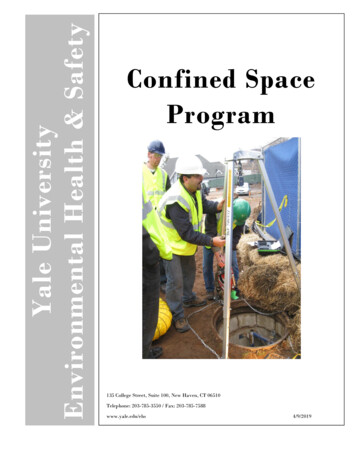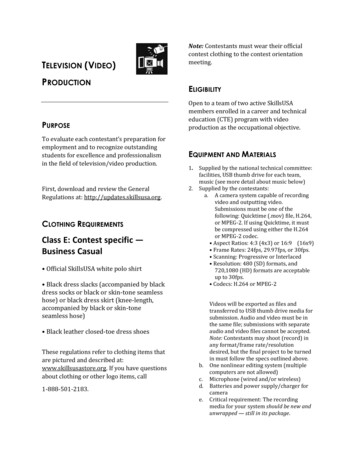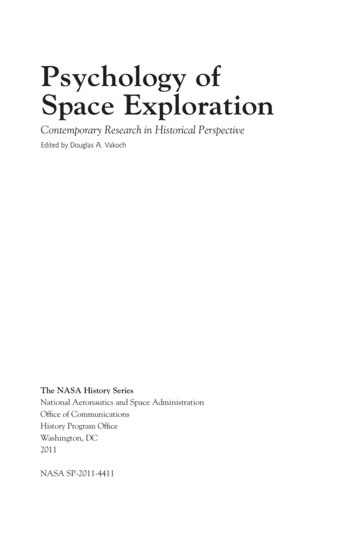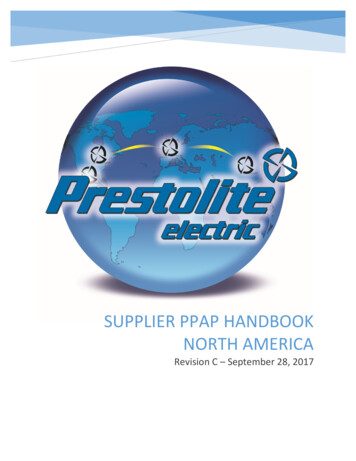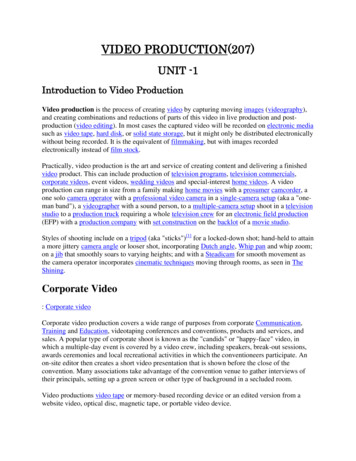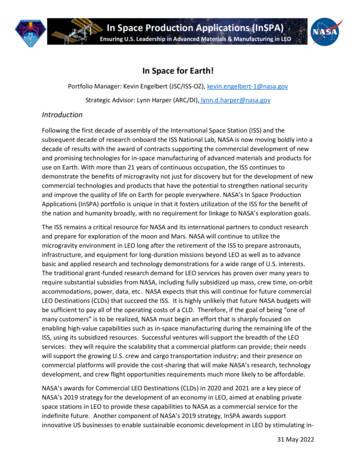
Transcription
In Space Production Applications (InSPA)Ensuring U.S. Leadership in Advanced Materials & Manufacturing in LEOIn Space for Earth!Portfolio Manager: Kevin Engelbert (JSC/ISS-OZ), kevin.engelbert-1@nasa.govStrategic Advisor: Lynn Harper (ARC/DI), lynn.d.harper@nasa.govIntroductionFollowing the first decade of assembly of the International Space Station (ISS) and thesubsequent decade of research onboard the ISS National Lab, NASA is now moving boldly into adecade of results with the award of contracts supporting the commercial development of newand promising technologies for in-space manufacturing of advanced materials and products foruse on Earth. With more than 21 years of continuous occupation, the ISS continues todemonstrate the benefits of microgravity not just for discovery but for the development of newcommercial technologies and products that have the potential to strengthen national securityand improve the quality of life on Earth for people everywhere. NASA’s In Space ProductionApplications (InSPA) portfolio is unique in that it fosters utilization of the ISS for the benefit ofthe nation and humanity broadly, with no requirement for linkage to NASA’s exploration goals.The ISS remains a critical resource for NASA and its international partners to conduct researchand prepare for exploration of the moon and Mars. NASA will continue to utilize themicrogravity environment in LEO long after the retirement of the ISS to prepare astronauts,infrastructure, and equipment for long-duration missions beyond LEO as well as to advancebasic and applied research and technology demonstrations for a wide range of U.S. interests.The traditional grant-funded research demand for LEO services has proven over many years torequire substantial subsidies from NASA, including fully subsidized up mass, crew time, on-orbitaccommodations, power, data, etc. NASA expects that this will continue for future commercialLEO Destinations (CLDs) that succeed the ISS. It is highly unlikely that future NASA budgets willbe sufficient to pay all of the operating costs of a CLD. Therefore, if the goal of being “one ofmany customers” is to be realized, NASA must begin an effort that is sharply focused onenabling high-value capabilities such as in-space manufacturing during the remaining life of theISS, using its subsidized resources. Successful ventures will support the breadth of the LEOservices: they will require the scalability that a commercial platform can provide; their needswill support the growing U.S. crew and cargo transportation industry; and their presence oncommercial platforms will provide the cost-sharing that will make NASA’s research, technologydevelopment, and crew flight opportunities requirements much more likely to be affordable.NASA’s awards for Commercial LEO Destinations (CLDs) in 2020 and 2021 are a key piece ofNASA’s 2019 strategy for the development of an economy in LEO, aimed at enabling privatespace stations in LEO to provide these capabilities to NASA as a commercial service for theindefinite future. Another component of NASA’s 2019 strategy, InSPA awards supportinnovative US businesses to enable sustainable economic development in LEO by stimulating in31 May 2022
In Space Production Applications (InSPA)Ensuring U.S. Leadership in Advanced Materials & Manufacturing in LEOspace production of advanced materials and biomanufacturing products for commercialmarkets and public benefits on Earth.The purpose of NASA’s InSPA program is to provide funding and expertise to help the mostpromising U.S. innovators traverse the technology “Valley of Death” by proving out theirconcepts for space manufactured materials and products on ISS such that other public andprivate-sector investors can confidently join in during the commercialization phase. The ISSNational Lab (NL) is an enabling partner and valuable resource for those seeking to develop anddemonstrate advanced materials and emerging technologies for this purpose. Drawn fromadvances over the past decade on ISS coupled with new product needs in high technology andhealth sectors, innovative US companies in the InSPA portfolio are expected to advancesolutions with high economic value by leveraging the capabilities and resources of microgravitythrough the ISS National Lab.In 2021, NASA expanded these efforts by reaching out to other Government Agencies (e.g. DoD,NIST, and NIH) for opportunities to collaborate on solutions that serve national interests orbroad public benefits. NASA is not the customer for these technologies; NASA’s explorationneeds for technology demonstrations utilizing In Space Manufacturing are implemented andmanaged separately from InSPA. As of February 2022, NASA has provided seed money inexcess of 38 million for more than a dozen technologies to enable innovative companies tomature their in-space manufacturing concepts and stimulate demand for future markets. Theawards are a key element of NASA’s goal to develop a robust economy in low-Earth orbit (LEO)where NASA will be one of many customers. In March 2022, NASA selected eight additionalproposals from U.S. businesses, institutions of higher learning, and other organizations totaling 21M to raise the technological readiness level of their manufacturing technologies andproducts, move them to market, and to propel U.S. industry toward developing a sustainable,scalable, and profitable non-NASA demand for products and services in LEO. These awards willlead to later phase awards for companies that successfully meet the pre-defined successcriteria, ultimately leading to transition to commercial operations on a CLD of their choosing.InSPA Portfolio DetailsMissionEnsuring U.S. leadership of in-space manufacturing in low-Earth orbit by enabling the use of theISS NL to demonstrate the production of advanced materials and products for terrestrialmarkets.VisionA robust and sustainable space economy where a diverse portfolio of U.S. companies operate abroad array of commercially owned productions facilities alongside government and privateastronauts living and training on the Commercial LEO Destinations that follow the ISS.31 May 2022
In Space Production Applications (InSPA)Ensuring U.S. Leadership in Advanced Materials & Manufacturing in LEOStrategic Goals1. Serving U.S. national interests by developing technologies that strengthen industryleadership, improve national security, and create high-quality jobs.2. Providing benefits to humanity by developing products that significantly improve thequality of life for people on Earth.3. Enabling the development of an economy in LEO by stimulating demand for scalable andsustainable non-NASA utilization of future commercial LEO destinations.Technologies of Interest Advanced Materials: Exotic Glasses and Fibers, Alloys, Ceramics, Semiconductors, IndustrialCrystals, Large and Small Molecule Crystals, Uniform Protein Crystals for Pharmaceuticals,etc.Bio-Manufacturing: Artificial Retinas, Stem Cell Reprogramming, Production andDifferentiation for Personalized Medicine, Bioprinting of Organoids and Whole Organs,Nerve Regeneration Medical Devices, etc.Award PhasesAwards are made thru a competitive selection process to proposals submitted to the NASAResearch Announcement (NRA) for ISS Utilization. New technologies are selected and onramped based on their intrinsic merit, business case and feasibility. As budget permits,concepts that successfully achieve Phase 1 exit criteria are invited to submit a proposal for the2nd phase. Similarly, Phase 2 awards that achieve exit criteria may lead to a Phase 3 award,budget permitting. InSPA awards are typically flown under sponsorship of the ISS NL throughcollaboration with Center for the Advancement of Science in Space (CASIS). The 3 InSPA Phasesare 1. Proof of Commercial Viability: development and launch of a basic flight experiment fortesting on the ISS to demonstrate scientific hypothesis, hardware performance andmanufacturing process control. Anticipate 2-5 flight demos resulting in a product that iscomparable to Earth-based state of the art.2. Proof of Production Quality: development and launch of an advanced flight experiment and3-5 additional ISS demos to achieve full production control, meeting specific performancetargets that exceed Earth-based state of the art. Requesting 20% non-NASA investment tosignal market interest and profit potential.3. Scaling and Logistics Demos: Scaled Flight hardware production and in-flight operations oneither ISS NL or a commercial LEO destination/platform to demonstrate commercialoperations and end-to-end logistics model producing sufficient quantities to close thebusiness case. Requesting 80% non-NASA investment.31 May 2022
In Space Production Applications (InSPA)Ensuring U.S. Leadership in Advanced Materials & Manufacturing in LEOInSPA Phase 1InSPA Phase 2InSPA Phase 3Basic Flight HardwareDevelopment andDemonstration in Microgravityfor proof of Commercial ViabilityAdvanced Flight HardwareDevelopment andDemonstration in Microgravityfor proof of Production QualityScaled/Automated ProductionFacility Development andOperation in CommercialMicrogravity EnvironmentKey Points The Business Case matters - Transportation costs, while declining, are still a major costcontributor, so the in-space product must be good enough to capture a sizable market ormeet important national/public needs such that there is a long-term commercial viabilityIt takes practice - ug is both good and bad; we can accomplish amazing things, butunexpected challenges often arise, and failures are expected, so multiple iterations will berequired.We are in a race – The Europeans and Chinese are investing heavily and will capturemarkets and compete for leadership of in-space production if we don’t sustain a steadypipeline of new ideas and provide the assistance needed to achieve commercial readiness.2022 Awards Biomanufacturing of Drug-Delivery Medical DevicesAuxilium Biotechnologies, Inc. of San Diego will develop a drug-delivery medical device tomore effectively treat people who have sustained traumatic peripheral nerve injury.Auxilium’s NeuroSpan Bridge is a biomimetic nerve regeneration device that guides andaccelerates nerve regeneration, eliminating the need for a patient to sacrifice a nerve in theleg to repair a nerve in the arm or face. Expansion of Hematopoietic Stem Cells for Clinical ApplicationBioServe Space Technologies and The University of Colorado Boulder will develop aspecialized bioreactor that will produce large populations of Hematopoietic Stem Cells(HSCs) to treat serious medical conditions including blood cancers, blood disorders, severeimmune diseases, and certain autoimmune diseases, such as rheumatoid arthritis. Ifsuccessful, the technology may enable safe and effective cell therapy transplantation,especially in children and younger adults, where long-term bone marrow cell repopulationis critical to the patient’s lifetime health. Establishing Production of Stem Cell TherapiesCedars-Sinai Regenerative Medicine Institute, in Los Angeles, will pursue production anddifferentiation of induced pluripotent stem cells (iPSCs) into heart, brain, and blood tissuesin support of regenerative medicine uses on Earth.31 May 2022
In Space Production Applications (InSPA)Ensuring U.S. Leadership in Advanced Materials & Manufacturing in LEO Fabrication of FlawlessGlass in MicrogravityFlawless Photonics, Inc. of Los Altos Hills, California, will develop specialized glassmanufacturing hardware to process Heavy-Metal Fluoride Glasses (HMFG) in microgravityfor terrestrial manufacturing of exotic optical fibers and other optics applications. Volumetric Additive Manufacturing for Organ ProductionLawrence Livermore National Laboratory, located in Livermore, California, will adapt theirvolumetric 3D bioprinting device for use in microgravity to demonstrate production ofartificial cartilage tissue in space. The Volumetric Additive Manufacturing (VAM) technologyis a revolutionary, ultra-rapid 3D printing method that solidifies a complete 3D structurefrom a photosensitive liquid resin in minutes. Pharmaceutical In space Laboratory Bio-crystal Optimization Xperiment (PIL-BOX)Techshot of Greenville, Indiana, a Redwire company, is developing the PIL-BOX system toproduce small, uniform protein crystals as stable seed batches for pharmaceutical andinstitutional research customers seeking improvements/refinements in product purification,formulation and/or delivery. Biomimetic Fabrication of Multifunctional DNA-inspired NanomaterialsThe University of Connecticut out of Storrs, Connecticut, in partnership with Eascra Biotechof Boston, Massachusetts will demonstrate biomimetic fabrication of multifunctionalnanomaterials, to be used as effective, safe, and stable delivery vehicles for RNAtherapeutics and vaccines, as well as first-in-kind injectable scaffolds for regenerativemedicine. Semimetal-Semiconductor Composite Bulk CrystalsUnited Semiconductors of Los Alamitos, California, will produce semimetal-semiconductorcomposite bulk crystals commonly used in electromagnetic sensors for solving challenges inthe energy, high performance computing and national security sectors. Analyzing Global Competition and U.S. Leadership in Low-Earth Orbit Commercializationof In-Space Production ApplicationsIn addition to the awards above, NASA made an award for a global market study of in-spaceproduction and manufacturing. The Institute for Defense Analyses (IDA), headquartered inAlexandria, Virginia, was tasked to help inform NASA’s strategy and plans for enabling inspace manufacturing by studying global competition and the potential impact on U.S.leadership in key technology areas. IDA’s Science and Technology Policy Institute (STPI) will31 May 2022
In Space Production Applications (InSPA)Ensuring U.S. Leadership in Advanced Materials & Manufacturing in LEOanalyze the current and future capabilities, investments, and policies of space-faringnations, including China, related to on-orbit manufacturing of advanced materials andproducts to better inform the priorities for U.S. Government investments in InSPA towardsdeveloping a commercial low-Earth Orbit economy. A final report is expected in July orAugust of 2022.2020 Awards Protein-Based Artificial RetinasSpace Tango of Lexington, Kentucky, and its partner, LambdaVision of Farmington,Connecticut, are developing a system to manufacture protein-based artificial retinalimplants, or artificial retinas to treat millions of patients suffering from retinal degenerativediseases, including retinitis pigmentosa (RP) and age-related macular degeneration (AMD), aleading cause of blindness for adults over 55 years old. The microgravity environment ofspace hinders convection and sedimentation in the manufacturing process, enabling moreuniform layers, improved stability and higher quality thin films than can be produced onEarth. The team successfully achieved their target of 200 layers on their past two flights(SpX-24 and Crew-4) and has one additional flight remaining under the InSPA award.PreflightSpaceX-24(200 layers)Crew-4(200 layers) Stem Cell ProductionSpace Tango and its partner Cedars-Sinai are developing pilot-scale systems for theproduction in space of large batches of stem cells to be used in personalized medicaltreatment for a variety of diseases. The pilot-scale systems, built for the space station toserve as a basis for future commercial manufacturing systems, will incorporate regulatorystrategies to support FDA clinical trial production of personalized medicine stem celltherapies on the space station. Orbital Stem Cell LaboratorySpace Tango and its partners at UC San Diego/Sanford Consortium in La Jolla, California, areworking to establish a new on-orbit biomedical sector for stem cell advancement, with a31 May 2022
In Space Production Applications (InSPA)Ensuring U.S. Leadership in Advanced Materials & Manufacturing in LEOfully operational self-sustaining orbital laboratory anticipated by 2025. Stem cellsdifferentiate into tissue specific progenitors that can be used in microgravity to betterunderstand aging and immune dysfunction, providing an opportunity to accelerateadvances in regenerative medicine and the development of potential new therapeuticapproaches. The project completed the first of six Phase 1 ISS demonstrations after launchon SpX-24 and is about to launch again on SpX-25 for its 2nd demonstration. Universal Intelligent Glass Optics (UNIGLO)Apsidal LLC. of Los Angeles, California, is developing the UNIGLO module to process varioustypes of complex glasses in space from which optical fibers, fiber lasers, magnetic fibers,super-continuum sources, capillary optics and adiabatic tapers can be drawn. Market areasfor products from this module include specialty fibers for low-loss and high bandwidthcommunications, high-power fiber-amplifiers, IR counter measures, supercontinuumsources, medical applications, remote sensing, X-ray optics, and laser processing. High Power Impulse Plasma Source Semiconductor ManufacturingMade In Space of Jacksonville, Florida, a Redwire company, is developing the HiPIPS facilityas an autonomous, high throughput manufacturing capability for production of high quality,lower cost semiconductor chips at a rapid rate. Market applications include semiconductorsupply chains for telecommunications and energy industries.Prior Awards Industrial Crystallization Facility (ICF)Made In Space has developed the ICF to provide proof-of-principle for diffusion-basedcrystallization methods to produce high-quality optical crystals in microgravity relevant forterrestrial use. Market applications include ultra-fast optical switches, optical waveguides,optical circuit lithography, high-efficiency ultraviolet light production, and terahertz wavesensors. Space FibersFOMS Inc of San Diego, California, has developed a facility-class instrument for fiberfabrication in the microgravity environment to improve the quality of specialty optical fiberswith the promise of up to 100x reduction in insertion loss due to the suppression ofcrystallization and phase separation. Fiber Optic Production (FOP)31 May 2022
In Space Production Applications (InSPA)Ensuring U.S. Leadership in Advanced Materials & Manufacturing in LEOMercury Systems of Torrance, California, has developed a facility-class instrument for fiberfabrication in the microgravity environment to improve the quality of specialty optical fiberswith the promise of up to two orders of magnitude reduction in insertion loss compared totraditional SiO2 fibers due to the suppression of crystallization and sedimentation. inDecember, 2020, Mercury successfully manufactured approximately 100m of ZBLAN opticalfiber on the ISS with performance comparable to fiber made on Earth. Mercury will conductfiber draws with its 2nd generation device on ISS after launch on SpX-25 in June of 2022. Turbine Ceramic Manufacturing Module (T-CMM)Made in Space has developed the T-CMM to provide proof-of-principal for single-piececeramic turbine blisk (blade disk) manufacturing in microgravity for terrestrial use. Theproject focuses on advanced materials engineering ultimately leading to reductions in partmass, residual stress, and fatigue. Strength improvements of even 1-2 percent can yield31 May 2022
In Space Production Applications (InSPA)Ensuring U.S. Leadership in Advanced Materials & Manufacturing in LEOyears-to-decades of superior service life. Market applications include high-performanceturbines, nuclear plants, or internal combustion engines. Turbine Superalloy Casting Module (T-SCM)Made in Space has developed the T-SCM to provide proof-of-principle for polycrystalsuperalloy part manufacturing in microgravity for terrestrial use. Market applicationsinclude turbine engines in industries such as aerospace and power generation. This awardhas reached the conclusion of its current award and is unlikely to continue under NASAfunding due to budget limitations. Biofabrication Facility (BFF)Techshot has developed the BFF as a space-based 3D biomanufacturing platform capable ofprinting with live human cells without the addition of scaffolding or chemical bio-inkthickening agents, required for 3D printing with cells on Earth. BFF prints in space with lowviscosity bio-inks that only contain cells and nutrients, which enable cells to remain healthyand mobile – a necessity for creating solid thick tissue. Industrial Cell Production LabTechshot has developed a ground prototype of a multi-functional laboratory tomanufacture induced pluripotent stem cells (iPSCs) in orbit using adult cells, then enablingthe cells to develop into many other types of cells, that can be used inside the BFFbioprinter and on Earth for regenerative medicine, especially cell therapies. Marketapplications include cell therapies for restorative health and autologous cell sourcing forbioprinting and vascular applications.31 May 2022
Biomanufacturing of Drug-Delivery Medical Devices Auxilium Biotechnologies, Inc. of San Diego will develop a drug-delivery medical device to more effectively treat people who have sustained traumatic peripheral nerve injury. Auxilium's NeuroSpan Bridge is a biomimetic nerve regeneration device that guides and


